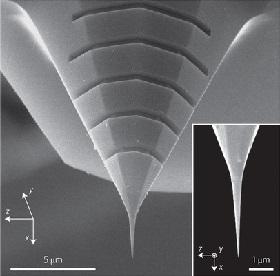Using AI to control energy for indoor agriculture
30 September 2024
Published online 31 October 2013

Light shone on the surface of a metal can be trapped in particle form. This unique phenomenon was exploited to develop highly sensitive nanoscale imaging and spectroscopic techniques.
The fleeting particle, known as surface plasmon polaritons (SPPs), eventually decays into highly energetic, or 'hot' electrons, limiting its usefulness in imaging applications. Recently, however, researchers have been able to harness hot electrons, but the low SPP-to-hot electron conversion ratio remained a problem.
Researchers led by Enzo Di Fabrizio from King Abdullah University of Science and Technology (KAUST) in Thuwal, Saudi Arabia, have conducted a series of proof-of-concept experiments showing an SPP-to-hot electron conversion rate of 30% efficiency, rather than the 1% previously possible, publishing their results in Nature Nanotechnology1.
To achieve this, they created a nanometer-sized cone of gold metal. The nanocone is supported on a Gallium-Arsenic semiconductor surface. This configuration favoured the decay of SPPs into hot electrons.
Based on this enhanced conversion ratio, the researchers demonstrate a new nanoscale imaging technique that can be used with atomic force microscopy to obtain stable, reproducible and high-resolution images of surfaces at the nanoscale.
This new technique is fully compatible with vibrational spectroscopy, which is used to analyze molecular composition, structure and interactions. Fabrizio's team now aims to combine the two to get new insight for protein structural and functional information.
doi:10.1038/nmiddleeast.2013.200
Stay connected: